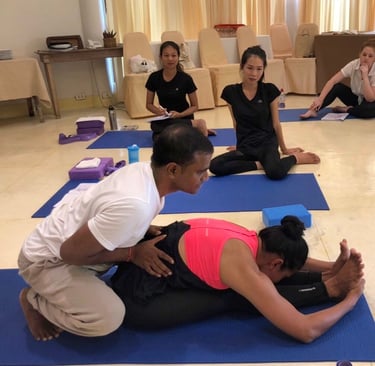How to do Paschimottanasana Step by Step
Blog post description.
Dr. Anil Singh
8/6/20223 min read


Paschimottanasana (Seated Back Stretch Pose) is a very important pose that many yoga practitioners want to do and some times struggle to do correctly. But learning properly to work on hamstring flexibility, lengthening and extending the back helps to achieve it with ease. ‘Paschim’ means ‘Back of the Body’ and Tana’ means ‘To Stretch’ thus this asana stretches the entire back of you body to enhance your physical flexibility. Activates vital forces ‘Prana’ of body to achieve higher goals of Yoga and brings mental calmness.
All about Paschimottanasana:
Sanskrit: Paschimottanasana (PASH-chee-moh-tan-AHS-ah-nah) ‘Paschim’ means ‘Back of the Body’ and Tana’ means ‘To Stretch’ thus this asana stretches the entire back of you body.
Apart from modern understanding Paschimottanasana is described in Hatha Yoga Pradipika from verse number 30 to 31 in its 1st Chapter where it talks about its techniques and benefits.
प्रसार्य पादौ भुवि दण्ड-रूपौ, दोर्भ्यां पदाग्र-दवितयं गॄहीत्वा |
जानूपरिन्यस्त-ललाट-देशो, वसेदिदं पश्चिमतानमाहुः || ३० ||
prasārya pādau bhuvi daṇḍa-rūpau, dorbhyāṃ padāghra-dvitayaṃ ghṝhītvā |
jānūparinyasta-lalāṭa-deśo, vasedidaṃ paśchimatānamāhuḥ || 30 ||
Having stretched the feet on the ground, like a stick, and having grasped the toes of both the feet with both the hands, when one sits with his forehead resting on the knees, it is called Paśchimatāna.
इति पश्चिमतानमासनाग्रं, पवनं पश्चिम-वाहिनं करोति |
उदयं जठरानलस्य कुर्याद, उदरे कार्श्यमरोगतां च पुंसाम || ३१ ||
iti paśchimatānamāsanāghryaṃ, pavanaṃ paśchima-vāhinaṃ karoti |
udayaṃ jaṭharānalasya kuryād, udare kārśyamaroghatāṃ cha puṃsām || 31 ||
This Paśchimatāna carries the air from the front to the back part of the body (i.e., to the suṣumna). It kindles gastric fire, reduces obesity and cures all diseases of men.
In addition to benefits mentioned in Hatha Yoga Pradipika and calming your mind and relieving stress, this pose stretches your spine, shoulders, and hamstrings. It also stimulates the liver, kidneys, ovaries, and uterus—and can help improve digestion.
This posture looks like an easy pose, but if you have tight back, hips and hamstrings it can be a challenging task for you. But practicing it with intention to achieve step by step techniques to work on hamstrings, hips and spine flexibility and following the right process will make you to achieve this pose in some times. You also have to remember to activate the quads and make space for the front of your body.
Step-by-step Guide:
Sit in Dandasana (Staff Pose). Pull your toes back and press the heels away from your body; press your palms and finger tips into the floor beside your hips.
Inhale. Raise your arms up by keeping your front torso long, exhale and fold forward from your hip joints. Lengthen the spine to fold forward without rounding your back.
Catch hold your feet from outside as far as they will go.
With each inhalation, lift and lengthen your front torso slightly; with each exhalation, move for
ward release a little more to forward fold. If you are holding your feet, bend your elbows out to the sides or take your elbows on the mat/floor.
Stay in the pose from 1–3 minutes.
To come up, release your feet. Inhale and lift your arms and torso up, exhale and take your arms down.
Beginner’s do this:
Try not drop your head and shoulders down toward your knees and keep your chin away from your chest. Target your forehead to place on shin close to ankles instead putting on knees. Keep the back long all the time and pull the bally back. In Pascimottanasana maintains a flat back. If your hamstrings are tight and you can’t reach your feet, practice with a strap around the feet. Inhale to lengthen your spine, and exhale to hinge forward slightly from hip joints. Continue this very subtle motion for several breaths to a few minutes.
Teacher’s do this while teaching Paschimottanasana to students:
Use these cues to help your students to do correctly, avoid injury and help them have the best experience in the pose:
Flex your feet and actively press your heels forward. Activate your top thighs in and press them down into the floor.
If you need more space for your stomach or chest, separate your legs slightly—not wider than the width of your hips.
For people with tight hamstrings, placing a folded towel under knees or bending your knees slightly will make the pose more easy. This also puts less pressure on your abdomen and diaphragm.
Follow this video tutorial to achieve Paschimottanasana step by step and correctly.






